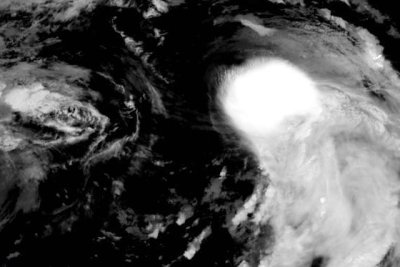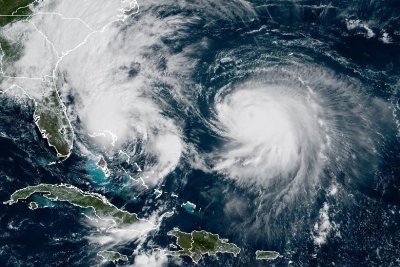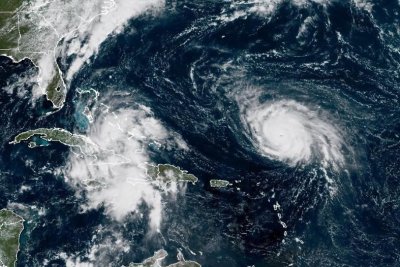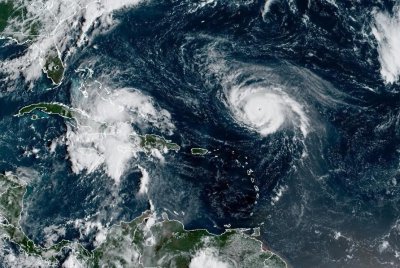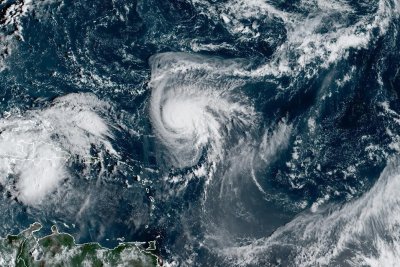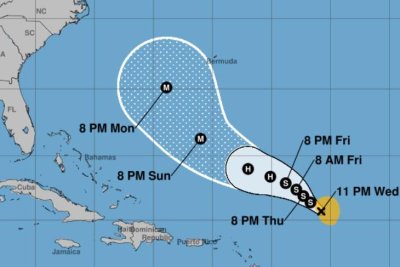1 of 3 | Hurricane Humberto (R) remained a major hurricane on Saturday morning. Potential Tropical Cyclone Nine (L) is forecast to become Tropical Storm Imelda early Sunday. Photo courtesy of NOAA
Sept. 27 (UPI) — Humberto remained a major hurricane Saturday morning and is headed to Bermuda as another potential storm later threatens Cuba, the Bahamas and the eastern United States, the National Hurricane Center said.
Humberto, the eighth named storm of the Atlantic season, had maximum sustained winds of 145 mph as a Category 4, with additional strengthening forecast through the weekend, NHC officials said in a 5 a.m. EDT update. Humberto became the season’s fourth hurricane on Friday morning.
The eye of the storm was located about 375 miles northeast of the northern Leeward Islands. It was moving northwest at 6 mph.
The forecast track has Humberto moving northward at a slightly faster forward speed through the weekend with a turn north-northwest on Monday night.
Swells generated by Humberto will start affecting portions of the northern Leeward Islands, the Virgin Islands, Puerto Rico and Bermuda this weekend, NHC said. They are likely to cause life-threatening surf and rip current conditions.
“As Humberto gains latitude, a significant expansion in the surface wind field will likely occur while it passes west of Bermuda,” NHC forecaster Lisa Bucci said in a discussion.
NHC shows Bermuda in NHC’s cone early Wedesday as a major storm. Humberto will move eastward out to sea on Thursday.
No coastal watches or warnings were in effect as of Saturday morning.
Hurricane-force winds extend outward up to 25 miles from the center of the storm, and tropical-force one outward to 105 miles.
Humberto became the Atlantic hurricane season’s eighth named storm on Wednesday. It’s the third hurricane after Erin and Gabrielle.
In August, Erin intensified into a Category 5 hurricane with 160 mph winds spreading across a 500-mile area. It did not make landfall in the United States but caused dangerous surf, rip currents and coastal flooding along the East Coast, with the worst conditions in North Carolina and Virginia.
Gabrielle formed in mid-September and also became a major hurricane, a Category 4. The storm dissipated into a post-tropical cyclone near the Azores on Friday.
Tropical Storm Chantal was the only storm to make landfall in the U.S. — South Carolina on July 6.
By Sept. 27 last year, there were 10 named storms with one other storm forming later in September.
Potential tropical cyclone
Another storm of concern in the Atlantic is Potential Tropical Cyclone Nine, which is forecast to become a depression on Saturday night and Imelda early Sunday. A hurricane is projected for Monday night east of Florida’s northern coast.
In the 8 a.m. EDT NHC advisory, the storm had maximum sustained winds of 35 mph and was about 170 miles northwest from the tip of Cuba and about 180 miles south of the Central Bahamas. It was moving northwest at 9 mph.
A tropical storm warning is in effect for the Central Bahamas and San Salvador, while a tropical storm watch is in effect for portions of the northwest Bahamas.
Moving north-northwest through Monday, the storm is expected to track across the central and northwestern Bahamas this weekend and approach the U.S. coast early next week. Eastern Cuba is expected to see 8 to 12 inches of rain with the potential for up to 16 inches of rain in isolated areas, which the Bahamas is predicted to see 4 to 8 inches of rain, forecasters said.
“Moisture from the disturbance will lead to a threat of heavy rainfall well to the north across portions of the Southeast U.S. and Virginia into early next week which could cause flash, urban, and river flooding,” NHC said.
Swells generated by the cyclone, as well as Hurricane Humberto, will affect parts of the Bahamas this weekend and are predicted to spread to the southeast U.S. coast early next week. The potential for swells could cause life-threatening surf and rip current conditions, NHC said.


